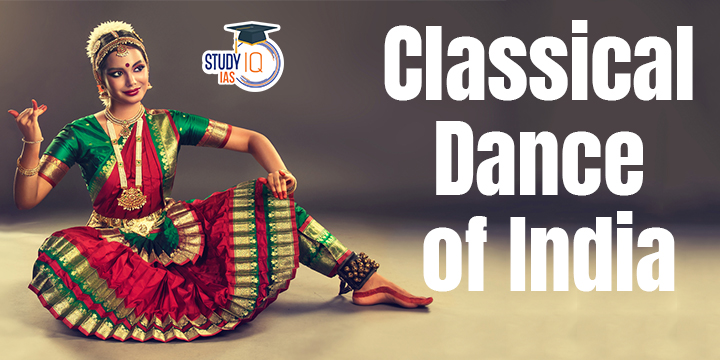Table of Contents
India boasts a rich tapestry of classical dances, each of 8 Classical Dances of India is a vibrant expression of cultural heritage. Bharatanatyam from Tamil Nadu features intricate footwork, while Kathak from North India narrates tales through rhythmic gestures. Odissi, rooted in Odisha, celebrates devotion, and Kuchipudi from Andhra Pradesh seamlessly blends dance, drama, and music. Kerala’s Kathakali is a captivating dance drama, while Mohiniyattam exhibits grace in Kerala. Manipuri from Manipur, and Assam’s Sattriya, reflect unique regional traditions, collectively embodying India’s diverse classical dance legacy.
Classical Dances of India
Classical Dance of India: Technicalities and rigid guidelines are a big part of classical dances. The technical underpinnings of all traditional dance forms are laid down in Acharya Nandikeshawara’s “Abhinaya Darpan,” Sharangdev’s “Sangeeth Ratnakar,” and the Natya Shastra (which includes their body movements, rasa, bhava etc). According to India’s Ministry of Culture, there are nine recognised classical dances. Dance is first mentioned in a well-known work in Bharat Muni’s book Natya Shastra. Folk and classical dances are just two of the many types of dance practised in India.
8 Classical Dances of India
Here is the List of Classical Dances of India:
| S.No |
Name of Classical Dance |
Place of Classical Dance |
| 1 | Bharatanatyam | Tamil Nadu |
| 2 | Kathak | Northern India |
| 3 | Kathakali | Kerala |
| 4 | Kuchipudi | Andhra Pradesh |
| 5 | Manipuri | Manipur |
| 6 | Mohiniyattam | Kerala |
| 7 | Odissi | Odisha |
| 8 | Sattriya | Assam |
Dance Forms in India
Indian classical and Folk dance are the two main types of dance forms in India. The place of origin is the main distinction between classical and folk dance. The Natya Shastra, which describes the distinctive characteristics of each of the classical dance styles, has a long history with classical dance. On the other hand, folk dance developed from the regional customs of the individual state, ethnic group, or geographic area.
9 classical dances of India are mentioned below:
- Bharatanatyam, from Tamil Nadu.
- Kathak, from Uttar Pradesh.
- Kathakali, from Kerala.
- Kuchipudi, from Andhra Pradesh.
- Manipuri, from Manipur.
- Mohiniyattam, from Kerala.
- Odissi, from Odisha.
- Sattriya, from Assam.
- Chhau From Jharkhand, West Bengal, and Odisha
Classical Dances of India with States
|
Dance Forms |
Location |
Significance |
| Bharatanatyam | Tamil Nadu |
|
| Kuchipudi | Andhra Pradesh |
|
| Kathakali | Kerala |
|
| Mohiniyattam | Kerala |
|
| Odissi | Odisha |
|
| Manipuri | Manipur |
|
| Sattriya | Assam |
|
| Kathak | Uttar Pradesh |
|
Famous Classical Dancer in India
|
Dancer |
Dance |
| Rukmini Devi Arundale | Bharatnatyam |
| Pandit Birju Maharaj | Kathak |
| Uday Shankar | Fusion |
| Kelucharan Mohapatra | Odissi |
| Guru Bipin Singh | Manipuri |
| Guru Vempati Chinna Satyam | Kuchipudi |
| Padma Subrahmanyam | Bharatnatyam |
| Shovana Narayan | Kathak |
Classical Dances of India Components
From the musical play or sangeet-nataka performed from the 12th to the 19th century, contemporary classical dance styles have developed. Tandava (movement and rhythm) and Lasya are the two fundamental elements of Indian classical dance (grace, bhava & rasa). The three primary elements are-
- Natya (the dramatic element of the dance i.e. the imitation of characters)
- The Nritta (the dance movements in their basic form)
- Nritya (expressional component i.e. mudras or gestures)
These are the nine rasas: love, heroism, pathos, humour, anger, fear, disgust, wonder, and peace. The Natya Shastra, authored by Bharat Muni, is the primary work used by Indian aestheticians to define the features of dance.
Classical Dances of India UPSC
The Ministry of Culture also recognises Chhau Dance as a classical dance of India, bringing the total number of classical dances in India to nine. Sangeet Natak Academy (India’s National Academy) only recognises eight of these dances.
Several crucial aspects of chhau dance are as follows:
- The Chhau Dance has meaning because of the name “Chaya.” Chaya is Hebrew for shadow
- Chhau dance is identified as a mask dance.
- An essential component of Chhau Dance is its energetic martial arts moves.
- Chhau Dance uses a number of narrations, including Serpent Dance and Peacock Dance.
- The Chhau Dance comes in three varieties: The Chhau dance known as Saraikella is well-known in Jharkhand, as is the Chhau dance known as Mayurbhanj in Odisha, and the Chhau dance known as Purulia in West Bengal.
- Masks are not used in the Mayurbhanj Chhau Dance.
- The Chhau Dance was added to the Representative List of Intangible Cultural Heritage of Humanity maintained by UNESCO.


 Jallianwala Bagh Massacre, Date, History...
Jallianwala Bagh Massacre, Date, History...
 NCERT Books for UPSC Preparation, Check ...
NCERT Books for UPSC Preparation, Check ...
 UPSC Syllabus 2025, Check UPSC CSE Sylla...
UPSC Syllabus 2025, Check UPSC CSE Sylla...





















